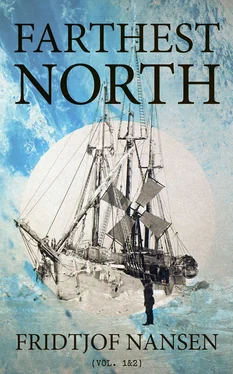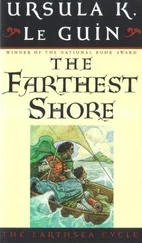Admiral Sir George Nares said:
“The adopted Arctic axioms for successfully navigating an icy region are that it is absolutely necessary to keep close to a coast line, and that the farther we advance from civilization, the more desirable it is to insure a reasonably safe line of retreat. Totally disregarding these, the ruling principle of the voyage is that the vessel—on which, if the voyage is in any way successful, the sole future hope of the party will depend—is to be pushed deliberately into the pack-ice. Thus, her commander—in lieu of retaining any power over her future movements—will be forced to submit to be drifted helplessly about in agreement with the natural movements of the ice in which he is imprisoned. Supposing the sea currents are as stated, the time calculated as necessary to drift with the pack across the polar area is several years, during which time, unless new lands are met with, the ice near the vessel will certainly never be quiet and the ship herself never free from the danger of being crushed by ice presses. To guard against this the vessel is said to be unusually strong, and of a special form to enable her to rise when the ice presses against her sides. This idea is no novelty whatever; but when once frozen into the polar pack the form of the vessel goes for nothing. She is hermetically sealed to, and forms a part of, the ice block surrounding her. The form of the ship is for all practical purposes the form of the block of ice in which she is frozen. This is a matter of the first importance, for there is no record of a vessel frozen into the polar pack having been disconnected from the ice, and so rendered capable of rising under pressure as a separate body detached from the ice block, even in the height of summer. In the event of the destruction of the vessel, the boats—necessarily fully stored, not only for the retreat, but for continuing the voyage—are to be available. This is well in theory, but extremely difficult to arrange for in practice. Preparation to abandon the vessel is the one thing that gives us the most anxiety. To place boats, etc., on the ice, packed ready for use, involves the danger of being separated from them by a movement of the ice, or of losing them altogether should a sudden opening occur. If we merely have everything handy for heaving over the side, the emergency may be so sudden that we have not time to save anything...”
As regards the assumed drift of the polar ice, Nares expressed himself on the whole at variance with me. He insisted that the drift was essentially determined by the prevailing winds:
“As to the probable direction of the drift, the Fram , starting from near the mouth of the Lena River, may expect to meet the main pack not farther north than about latitude 76° 30′. I doubt her getting farther north before she is beset, but taking an extreme case, and giving her 60 miles more, she will then only be in the same latitude as Cape Chelyuskin, 730 miles from the Pole, and about 600 miles from my supposed limit of the effective homeward-carrying ocean current. After a close study of all the information we possess, I think the wind will be more likely to drift her towards the west than towards the east. With an ice-encumbered sea north of her, and more open water or newly made ice to the southward, the chances are small for a northerly drift, at all events, at first, and afterwards I know of no natural forces that will carry the vessel in any reasonable time much farther from the Siberian coast than the Jeannette was carried, and during the whole of this time, unless protected by newly discovered lands, she will be to all intents and purposes immovably sealed up in the pack, and exposed to its well-known dangers. There is no doubt that there is an ocean connection across the area proposed to be explored.”
In one point, however, Nares was able to declare himself in agreement with me. It was the idea “that the principal aim of all such voyages is to explore the unknown polar regions, not to reach exactly that mathematical point in which the axis of our globe has its northern termination.” 12
Sir Allen Young says, among other things: “Dr. Nansen assumes the blank space around the axis of the earth to be a pool of water or ice; I think the great danger to contend with will be the land in nearly every direction near the Pole. Most previous navigators seem to have continued seeing land again and again farther and farther north. These Jeannette relics may have drifted through narrow channels, and thus finally arrived at their destination, and, I think, it would be an extremely dangerous thing for the ship to drift through them, where she might impinge upon the land, and be kept for years.”
With regard to the ship’s form, Sir Allen Young says: “I do not think the form of the ship is any great point, for, when a ship is fairly nipped, the question is if there is any swell or movement of the ice to lift the ship. If there is no swell the ice must go through her, whatever material she is made of.”
One or two authorities, however, expressed themselves in favor of my plan. One was the Arctic traveller, Sir E. Inglefield, another Captain (now Admiral) Wharton, Director of the Hydrographic Department of England.
In a letter to the Geographical Society, Admiral Sir George H. Richards says, on the occasion of my address: “I regret to have to speak discouragingly of this project, but I think that any one who can speak with authority ought to speak plainly where so much may be at stake.”
With regard to the currents, he says: “I believe there is a constant outflow (I prefer this word to current) from the north, in consequence of the displacement of the water from the region of the Pole by the ice-cap which covers it, intensified in its density by the enormous weight of snow accumulated on its surface.” This outflow takes place on all sides, he thinks, from the polar basin, but should be most pronounced in the tract between the western end of the Parry Islands and Spitzbergen; and with this outflow all previous expeditions have had to contend. He does not appear to make any exception as to the Tegethoff or Jeannette , and can find no reason “for believing that a current sets north over the Pole from the New Siberian Islands, which Dr. Nansen hopes for and believes in. ... It is my opinion that when really within what may be called the inner circle, say about 78° of latitude, there is little current of any kind that would influence a ship in the close ice that must be expected; it is when we get outside this circle—round the corners, as it were—into the straight wide channels, where the ice is loose, that we are really affected by its influence, and here the ice gets naturally thinner, and more decayed in autumn, and less dangerous to a ship. Within the inner circle probably not much of the ice escapes; it becomes older and heavier every year, and in all probability completely blocks the navigation of ships entirely. This is the kind of ice which was brought to Nares’s winter quarters at the head of Smith Sound in about 82° 30′ north; and this is the ice which Markham struggled against in his sledge journey, and against which no human power could prevail.”
He attached “no real importance” to the Jeannette relics. “If found in Greenland, they may well have drifted down on a floe from the neighborhood of Smith Sound, from some of the American expeditions which went to Greely’s rescue.” “It may also well be that some of De Long’s printed or written documents in regard to his equipment may have been taken out by these expeditions, and the same may apply to the other articles.” He does not, however, expressly say whether there was any indication of such having been the case.
In a similar letter to the Geographical Society the renowned botanist Sir Joseph Hooker says: “Dr. Nansen’s project is a wide departure from any hitherto put in practice for the purpose of polar discovery, and it demands the closest scrutiny both on this account, and because it is one involving the greatest peril...
Читать дальше












